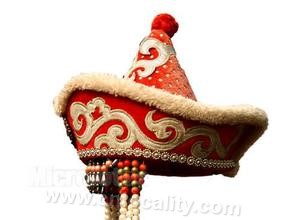welcomeSpecialty Foods Products!

Mongolian ancestors first made hats from mink, fox skin, sheepskin and other animal skins. Later, cotton, hemp, silk and other production materials gradually came into being. Its materials mainly come from the surrounding agricultural areas. Although headscarves came into being earlier than hats, Mongolians have always used them together. It's just that men wear headscarves in different ways and styles from women, and generally don't wear brightly colored headscarves. Mongolian hats are generally divided into two types: winter and summer. In the 12th ~ 13th century, Mongolian men put the feathers of Shanghai bluebird or peregrine falcon on the top of the hat and designed the style into the shape of a raptor, which was later called the hat with perched eagle crown. The origin of the crested eagle is related to the fact that some tribes in Mongolia regard the sea bluebird as their ancestor-totem. At that time, Mongolian adult men wore crests or domes, and the crests of nobles or Khan (tribal leaders) paid attention to texture. In summer, they used fine brocade, and in winter, they were made of fox and mink, with gold and jade beads. The lady wears a Bao Ge Ka (Bao Ge Tu Ge or Li Yi) hat. Mongolians pay attention to hats and how to wear them on any important occasions. When welcoming guests, both men and women should wear hats and come out to meet. This has a double meaning, on the one hand, to prove your dignity, on the other hand, to respect the guests. Especially in ancient times, women could not appear in front of strangers if they didn't have a hat or didn't have time to wear it. After modern times, there has been a serious difference between the rich and the poor in Mongolian society, but even the poorest families should try their best to buy the headdress of married girls. This has something to do with the Mongolian custom of respecting hats. It is worth mentioning that there are some extreme examples in Mongolian customs and culture. If you meet a particularly important person or hold a memorial service, you should take off your hat instead. This is true when paying homage to heaven and earth, kowtowing to Buddha and meeting respected elders. It is clearly recorded in the history books that when Genghis Khan was a child, he escaped the pursuit of the three surnames Mier Begging. After hiding in Buerhan Mountain, he took off his hat, uncovered his belt, kowtowed to the holy mountain with nine heads and made a long kneeling ceremony. Therefore, it is the most pious etiquette of Mongols to kowtow to the nine heads for a long ceremony.
Reprinted with attribution:
https://cnlocality.com/(Chinese Specialty Products)
other
consult:(+86)13225231905